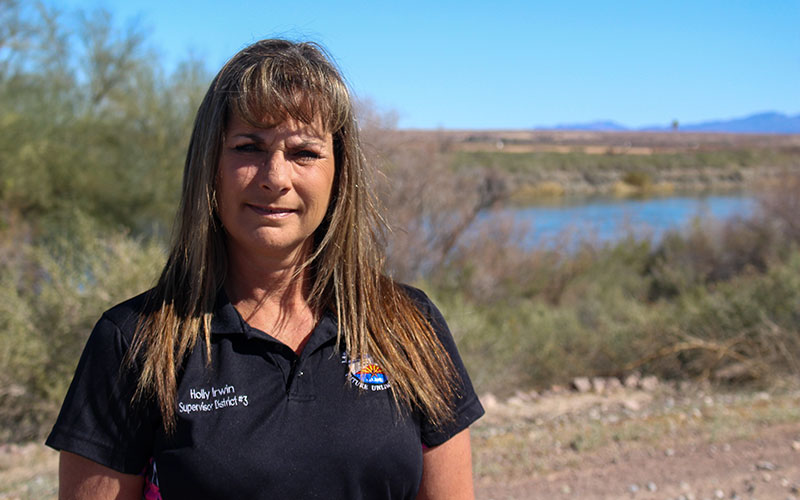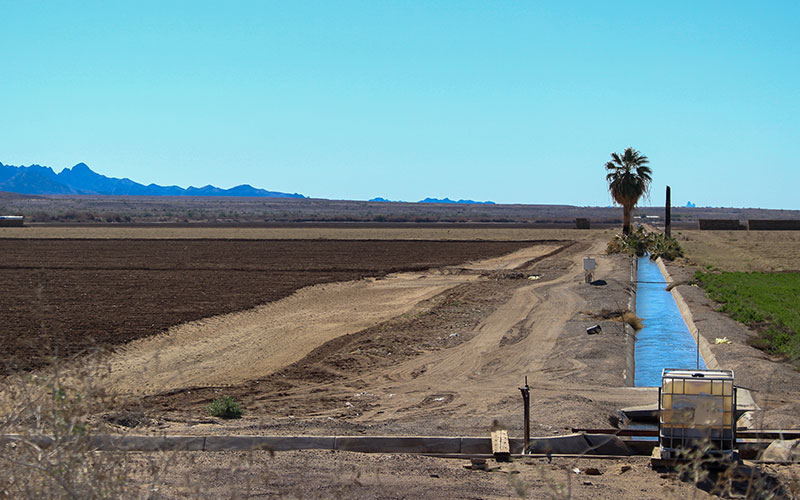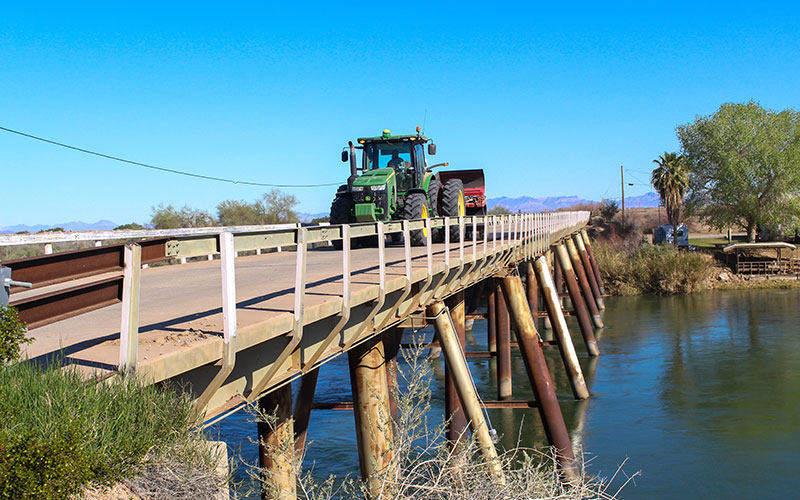
The Colorado River flows beneath the Farmers Bridge in Arizona’s Cibola Valley. (Photo by Bret Jaspers/KJZZ)
PHOENIX – Central Arizona has been booming – more people, more houses, more need for water. There’s also a long-term drought and less water to buy from the Central Arizona Project canal system. It’s leading Phoenix exurbs to cast about, looking for new buckets.
Other regions of the state are saying: Don’t come here.
“They want to come and take from the rural counties, which is completely wrong, in my opinion,” said Holly Irwin, a county supervisor in La Paz County, in far west Arizona. Her district is where the Colorado River runs along lush irrigated farmland and small towns.
Rural communities clash with metro exurbs
Irwin is pushing back against a plan to transfer water rights from some privately owned La Paz County farms to Queen Creek, likely never to return.
To her, it’s a slippery slope.
“There’s already people in line waiting to see if this is going to go through – entities,” she said. “And the minute the first one goes through, it’s like opening up flood gates and you’re never going to be able to close them.”
Queen Creek officials say this purchase would help the town grow sustainably.
“What we’re trying to do is get that groundwater pumping down to as close to zero as possible,” said Paul Gardner, Queen Creek’s utilities director. “We’re not going to quite get there, but we want to get as self-sufficient as possible on renewable supplies.”
Like other cities and towns on the outskirts of metro Phoenix, Queen Creek’s population has increased significantly, more than 60% since 2010 (although some of that was through annexation of existing homes).
The town would pay $10,000 an acre-foot for water rights tied to the farmland. The quantity is 2,083.1 acre-feet of Colorado River water, making the total price about $20.8 million. (An acre-foot is roughly what a family of four uses in a year.)
Asked whether it’s fair that water should go to the highest bidder, Gardner said, “I think water’s a market. And we don’t set the market. And the market is what the market is.”
The price is not exorbitant, experts say, considering that the sum pays for a right to water in perpetuity.

La Paz County Supervisor Holly Irwin opposes the deal to transfer water rights to Queen Creek. “The minute the first one goes through, it’s like opening up flood gates and you’re never going to be able to close them.” (Photo by Bret Jaspers/KJZZ)
Investors aim to cash in
There’s a major player at the heart of this deal. The Phoenix water-investment company Greenstone owns the La Paz County farmland through its subsidiary, GSC Farm. If the plan goes through, they’ll receive about $20.8 million for the water – about double what they spent on the land.
Greenstone is one of a handful of private investing firms looking at water scarcity in the West as a money making opportunity. Principals at Greenstone declined an interview for this story.
The firm has hired well-known Phoenix real estate attorney Grady Gammage Jr. After a hearing on the deal in November, Gammage rejected the notion that transferring these specific water rights will hurt development in rural Arizona.
“The amount of water that is there is vast, frankly,” he said. “The existing river communities only use about 40% of their existing municipal supply.”
This particular deal is unique, Gammage said, and it won’t create the slippery slope rural boosters are so worried about.
“To the knowledge of GSC Farm LLC and the town of Queen Creek, there are no other transfers of water to central Arizona currently contemplated, nor do the commenters identify any such possible transfers,” attorneys for GSC Farm said in response to public comments.
This land, however, is likely not the only property Greenstone owns in western Arizona. According to county records, limited liability corporations with the same Phoenix address as Greenstone own more than a thousand acres in Yuma County, just south of La Paz.
Many Yuma County residents are, like Irwin, staunchly against the transfer.

Some of the farmland in the Cibola Valley is owned by the Phoenix water investment firm Greenstone, which hopes to sell a large chunk of the land’s water rights to Queen Creek, a Phoenix exurb. (Photo by Bret Jaspers/KJZZ)
Development pressure continues in metro Phoenix
Water transfers like this – with some important differences – have been tried before. But water for new development in central Arizona is increasingly pricey and scarce, especially in communities on the outer edges of the Valley. And yet, people are moving there in high numbers.
“The development of housing in those areas tends to be less expensive than in the older cities,” said Sarah Porter of Arizona State University. “And those developers are required to find a water supply before they can develop.”
New development in central Arizona must show one hundred years of supply and have a plan to replenish any groundwater that’s pumped. One way to do that is to enroll houses in an agency called the Central Arizona Groundwater Replenishment District – known as CAGRD – which is tasked with replenishing pumped groundwater. The agency has consistently raised its prices, and it’s on the hunt for more water.
For Queen Creek, securing a renewable supply would keep it less reliant on the CAGRD.
Rural lawmakers, including state Rep. Regina Cobb, R-Kingman, say central Arizona towns need to live within their means.
“Queen Creek has a budget right now,” Cobb said. “And they’re not working within their budget. They’re saying, ‘I need more, I need more, and this is how I’m going to get more.’ And they’re using a heavy hand trying to do it.”

The Farmers Bridge crosses over the Colorado River and gives farmers access to their cropland in Arizona’s Cibola Valley. (Photo by Bret Jaspers/KJZZ)
Is compromise possible?
Robert Glennon at the University of Arizona has written extensively about water markets and thinks transfers like this can work, if properly designed. He thinks a water buyer could put money toward something the rural community wants, such as infrastructure to help farmers there use water more efficiently.
“I’m a huge fan of markets,” Glennon said. “And there’s a way to do this and a way not to do it.”
The proposed transfer doesn’t have that kind of local investment, and GSC Farm’s response to public comments did not include any such plan. It’s also unclear it would make a difference to people in western Arizona anyway. Cobb said she would fight the deal all the way to the U.S. Department of Interior, which has to approve the transfer of the water right.
Most observers believe Interior will put a lot of weight on whether the Arizona Department of Water Resources recommends the deal. After a request from entities in western Arizona, the department has a September deadline for issuing its recommendation.
In an email, the department said Tom Buschatzke, the agency’s director, “intends to utilize all the allotted time to review and consider all the collected data and public comments regarding the proposed transfer before issuing a recommendation.”
It’s a pivotal moment for those who have water, those who need water, and those in the middle who want their investment in water to ripen.
This story is part of a series on water investment in the West, produced by KUNC in Colorado, Aspen Journalism, KJZZ in Arizona and the Nevada Independent.